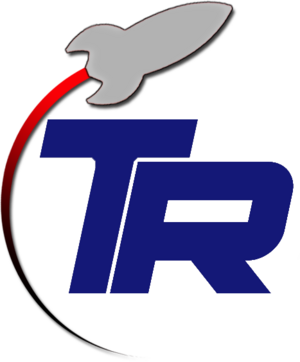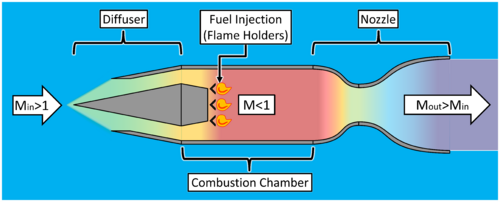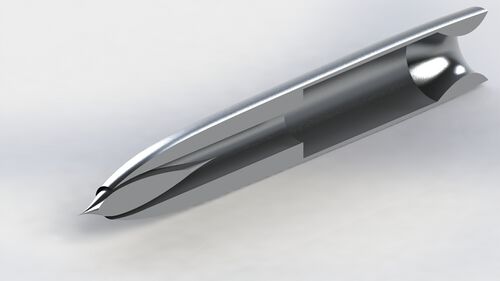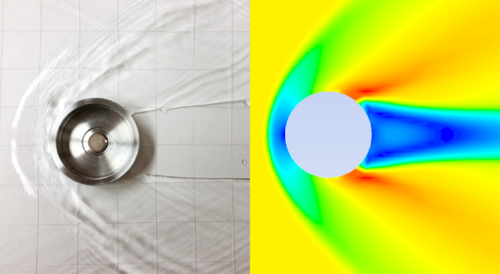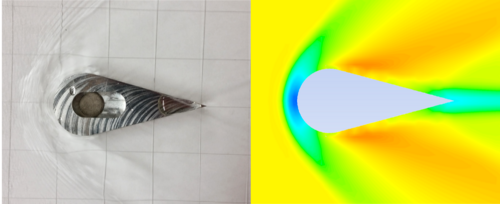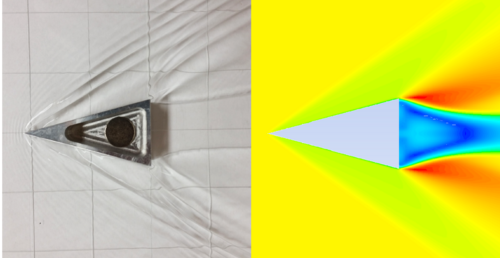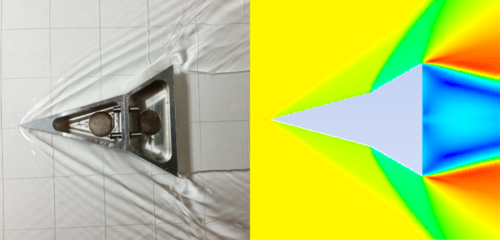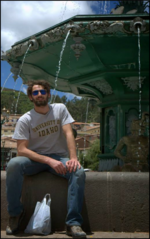Integrated Rocket Ramjet (IRR): Team Rocket
| Team Rocket Logo | |
| Sponsors | |
| Team Name | Team Rocket |
| Duration | Fall 2014 - Spring 2015 |
| Faculty Advisers | |
| Mentor |
|
| Students |
|
The goal is to design and model an Integrated Rocket Ramjet (IRR) engine design that will transition from the solid rocket phase to the liquid ramjet phase after reaching the designed speed while utilizing minimal breakaway parts or by means of control surfaces. The control surfaces will also serve as an inlet optimization tool to minimize exergetic losses into the combustion chamber and simultaneously maximize exit conditions for optimal thrust.
Problem Definition
Background
This design project requires an understanding of compressible flow (also known as gas dynamics), thermodynamics of fluids including exergy analysis, and current propulsion system designs including ramjets. Below are some of the basic equations that are pertinent to this project scope.
Speed of Sound:
- <math> a=\sqrt{\gamma R T_{abs}} \qquad \mbox{(1)} </math>
where a = Speed of Sound, <math>\gamma</math> = Specific Heat Ratio, R = Ideal Gas Constant, and <math>T_{abs}</math> = Absolute Temperature.
Mach Number:
- <math> M=V/a \qquad \mbox{(2)} </math>
where M = Mach Number and V = Velocity.
Below is the equation of thrust for an air breathing engine.
- <math> F_{thrust}=(\dot{m}+\dot{m}_{fuel})V_{out}-\dot{m}V_{in} \qquad \mbox{(3)} </math>
where <math>F_{thrust}</math> = Thrust, <math>\dot{m}</math> = Mass Flow Rate, and V = Velocity.
The thermal efficiency of an aircraft engine.
- <math> \eta_{th}=\frac{(\dot{m}+\dot{m}_{fuel})V_{out}^2-\dot{m}V_{in}^2}{2\dot{m}_{fuel}HC} \qquad \mbox{(4)} </math>
where <math>\eta_{th}</math> = Thermal Efficiency, and HC = Heat of Combustion.
The propulsive efficiency of an aircraft engine.
- <math> \eta_{p}=\frac{2V_{in}F_{thrust}}{(\dot{m}+\dot{m}_{fuel})V_{out}^2-\dot{m}V_{in}^2} \qquad \mbox{(5)} </math>
where <math>\eta_{p}</math> = Propulsive Efficiency.
Together, the thermal and propulsive efficiency define the overall efficiency of an aircraft engine.
- <math> \eta_{o}=\eta_{th}\cdot\eta_{p} \qquad \mbox{(6)} </math>
where <math>\eta_{o}</math> = Overall Efficiency.
| Video Reference | Summary |
|---|---|
| SR-71 Blackbird Turbo Ramjet Engine
This is one of our inspirations for the project. The SR-71 turbo ramjet engine utilizes an adjustable nose cone to optimize inlet conditions based on the speed it is flying. Our idea is similar, though we desire to possibly improve upon this design while integrating a solid rocket phase to initialize flight up to the designed speed and transition. | |
| High Efficiency Linear Aerospike Engine
The Aerospike engine serves to increase thrust efficiency, compensate for altitude pressure variation, and reduce the cost of manufacturing due to reduction of size and material. Even though the scope of our project is focused primarily on the intake control surfaces, the nozzle is crucial to any supersonic engine design. This is one of our considerations for the nozzle design that could potentially reduce the price of manufacturing while increasing thrust performance of our system, ultimately offering a superior economic advantage. |
Specifications
| General Requirement | Specific Requirement | Target Values |
|---|---|---|
| Flight Range | Typical flight ranges for supersonic payload delivery systems are approximately around 100 miles, while other subsonic payload delivery systems can be as high as 1,000+ miles in range. One objective is to potentially increase the total flight range to create an advantage over other systems. | 1,000+ Miles |
| High Efficiency | By analyzing the thermal and propulsive efficiency, the overall efficiency can be interpreted and optimized. Another means of analyzing aircraft engine performance is with the specific impulse of the fuel source. For this project, exergetic analysis will be performed to minimize energy loss entering the combustion chamber and ideally throughout the cycle. | <math>\eta_{o}</math> optimized |
| Adjustable Control Surface(s) | Adjustable control surfaces allow the integrated rocket ramjet (IRR) to control the inlet conditions into the combustion chamber which controls the exit conditions. Integrating a control scheme will allow for the IRR to optimize inlet conditions for a range of Mach numbers. | Choose an inlet control surface design |
| Combustion Conditions | After the inlet conditions are considered and selected, the combustion chamber is the next phase of the system that requires significant consideration. The two major subsystems involved are the fuel injectors and the flame holders. The actual chamber itself may require consideration due to the high temperatures of operation required for ramjet combustion. | Considerations for combustion chamber design |
| Develop a Working Model | Probably the most important aspect of this project is developing a working model of what is occurring throughout the system to serve as a prediction for shock wave locations, optimize inlet conditions, and develop working geometries. For this objective there are a number of tools that will be utilized to perform these tasks. | EES Code, CFD Simulation, Solidworks, and Design/Simulation |
Project Learning
Brainstorming
| Image | Summary |
|---|---|
| Standard Ramjet Model
A standard ramjet operates at supersonic velocities. The kinetic energy of the high velocity flow is converted to thermal energy when the flow reaches stagnation. Pressure increases through shock waves. The flow is slowed by the diffuser until the flow velocity is nearly zero. Entering the combustion chamber, fuel is introduced by means of flame holders which increases the pressure. The high pressure gases then exit through a nozzle which transitions the flow from subsonic back to supersonic. The exit velocity is greater than the inlet, which generates thrust. Ramjets typically have little to no moving parts and operate at high velocities making them desirable for supersonic design. | |
| Proposed IRR Design
Our proposed design starts as a subsonic Solid Fueled Rocket (SFR). The SFR utilizes grain propellant in the combustion chamber that is designed to get the rocket up to a Mach of ~3 before burning out. The diffuser is set forward and sealed such that there is no flow at the inlet. Once the SFR burns out, the diffuser will shift back blowing out a port cover into the combustion chamber and allowing air in. The flame holders are then uncovered and begin injecting liquid fuel initiating the Liquid Fueled Ramjet (LFR) phase. The nose cone will shift linearly to optimize the inlet flow to maximize pressure recovery. | |
| Qualitative Simulation Apparatus - Water Table
This design will take water from the receiving tank (bucket) from the water way which will then be pumped back to the laminar bay to deliver a thin laminar flow to the water way. With this, simple simulation can be performed by placing models in the water way and observing the hydraulic jumps (waves) produced by the model geometry. | |
| Ramjet Model Cross Section
This is the model that was developed in Solidworks. Based on the schematics, a scale replica ramjet was made using the senior design machine shop located in Gauss-Johnson Engineering building. It is desired to take the aluminum model and implement it into a display such that the nose cone can be controlled to move in or out much like the design concept proposed. |
Simulation & Validation
| Mach Number Color Scale | Side-by-Side Comparison | Summary |
|---|---|---|
| Cylinder in Cross Flow
The cylinder in cross flow acts as a blunt body that generates detached shock in front, also referred to as a bow shock. This is a widely studied model that has been simulated numerous times using CFD, water table experiments, and even using supersonic wind tunnels. Since this is the case, it serves as a comparison for calibrating the water table. | ||
| Teardrop Airfoil
An angle of attack of 0° in cross flow. This teardrop shape is used to compare the separation effects with the cylinder in cross flow. It can be observed that the teardrop shape has a smaller shadow zone which is a zone where the flow velocity is essentially zero. This is often more common with hypersonic flows because the fluid is travelling around the objects at a high enough velocity that there is no time for the high velocity, high pressure flow to reach equilibrium with the low velocity shadow zone. | ||
| 15° Turning Angle - Simple Wedge
This wedge has an included angle of 30 degrees, which means the flow turns 15 degrees. The water flow is disrupted by the wedge and forms a hydraulic jump that is analogous to an oblique shock wave for supersonic flow. The trailing edge causes a rapid expansion that causes the flow to increase in speed which is analogous to expansion waves for supersonic flow. | ||
| 15°-15° Turning Angles - Delta Wedge
Two consecutive 15° turning angles. This shape for the water table is the first 15° simple wedge with the addition of a Delta Wedge which is a center line symmetrical polyhedron with one side length equating to the back end of the 15° simple wedge. This was to simulate the concept of incorporating an infinite number of small turns to increase the pressure recovery through the shock waves. This concept was found to be feasible due to the inverse relationship between the turning angle of supersonic flows and the total pressure after the shock. As the turning angle increases, the total pressure downstream of the shock decreases. | ||
| IRR Water Table Demonstration
Water Table demonstration of the IRR transitional phase from solid fueled rocket to liquid fueled ramjet. The nose cone is set forward at the maximum position which is to simulate the solid fueled rocket phase. To simulate the transitional phase, then the diffuser nose cone recedes linearly behind the cowling allowing the flow to enter for the air breathing liquid fueled ramjet phase. Note that there is no combustion chamber or nozzle. | ||
Conclusions & Future Development
CFD Remarks
Due to the difficulty of CFD supersonic internal flow simulations, it was determined that the water table would serve as a means to provide a qualitative analysis of transient supersonic internal flow characteristics. With CFD simulations, developing the mesh for internal flow is time consuming and difficult. Supersonic internal flow conditions are also challenging due to the conflict in setting proper boundary conditions for the inlet(s) and outlet(s). The Water Table will be used in later project development to generate 2D models to simulate flow through the IRR. The information gathered from Water Table simulations can be used to better develop meshes for CFD.
CFD and Water Table do not have a 1-to-1 relationship between the Froude (Fr) and Mach numbers for oblique shock wave simulations which means that further testing may likely require the formation of a dimensionless relation(s).
Water Table Remarks
It may be worth redesigning and/or rebuilding the Water Table to account for several shortfalls that occurred. Some ideas for improvement are :
- Rebuild the water way so that it doesn't bow at the center. During testing, the Plexiglas would deflect at the center-line. To counter this, our team built an angled platform to reduce the depth of the laminar flow in the water way while also increasing the water velocity. This works, but the water way still bows. Perhaps a wider and longer water way can be developed to improve the water way structure, allow for variable water way angles, and increase the area of the water way surface to reduce wall interactions.
- Construct something that can go in the reservoir tank that will laminarize the flow before it enters the water way. In conventional wind tunnels, this is done with honeycomb mesh. It was proposed that the same effect could be obtained by using bundles of straws and placing them into the reservoir before entering the water way.
- Rebuild the reservoir with sturdier materials. One day, our team was showing off the Water Table to Dr. Crepeau and Dr. Xing because it was operational. The reservoir tank seam along the back (opposite of the water way) began to leak. Suddenly, it burst open splashing several gallons of water on our advisor Dr. Tao Xing. To fix this, all seams were chemically welded using an acid compound. It worked, but there is no guarantee for how long it will last.
- Implement vibration absorbing material to reduce or eliminate interference with the water way. During simulation, it can be observed that the water vibrates. This has been reduced by implementing foam upholstery material underneath and around the 1/2 hp pump in the receiving tank, but it is possible to reduce it further or even eliminate it entirely.
- Use bottom side lighting to better show the hydraulic jumps in the water way. It is sometimes difficult to see the ripples when there is topside lighting.
Future Team(s)
It was identified early on that a fundamental understanding of compressible flow is needed to comprehend the flow characteristics of the inlet. With the water table, now an analogy can be used to develop that understanding using concepts learned in fluid dynamics. But future teams would likely need gas dynamics to be able to fully contribute.
CFD prior to this design challenge would have been substantially better for the development of the project. It is a hard program and skill to learn, but it has provided substantial results that can be quantified using gas dynamics.
Team Information
| Steven Elsbury | Career Goals:
| |
| Mechanical Engineering Undergraduate | ||
| Hometown: Peck, Idaho | ||
| Email: elsb0048@vandals.uidaho.edu | ||
| Nate Randall | Career Goals:
| |
| Mechanical Engineering Undergraduate | ||
| Hometown: Boise, Idaho | ||
| Email: rand2315@vandals.uidaho.edu | ||
| Chance Sundquist | Career Goals:
| |
| Mechanical Engineering Undergraduate | ||
| Hometown: Boise, Idaho | ||
| Email: sund7867@vandals.uidaho.edu | ||
| Robert Willis | Career Goals:
| |
| Mechanical Engineering Undergraduate | ||
| Hometown: Filer, Idaho | ||
| Email: will7168@vandals.uidaho.edu |
Document Archive
Research Literature
Johns Hopkins - Integrated Rocket Ramjet History
SJSU Munoz, A. - Combined Cycle Engines
Unified Rocket Ramjet Engine I
Unified Rocket Ramjet Engine II
Georgia Tech - Optimizing Diffuser for Pressure Recovery
CalPoly Stone, P.C. - Ramjet Combustion Chamber
CalPoly Humphrey, C.C. - Ramjet Design and Fabrication
CalPoly Selin, K. - Ramjet Fuel System
UNLV Nelson, S.E. - CFD vs. Water Table Experiments
